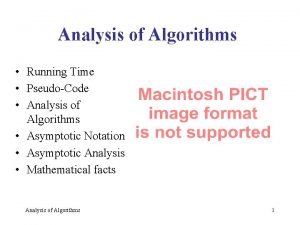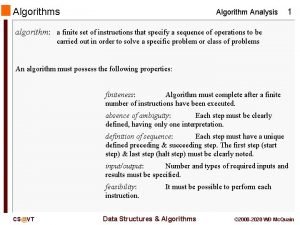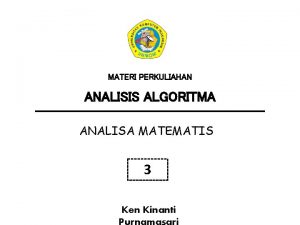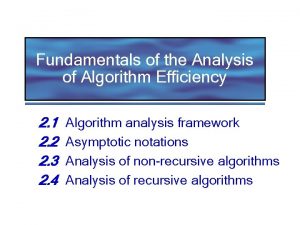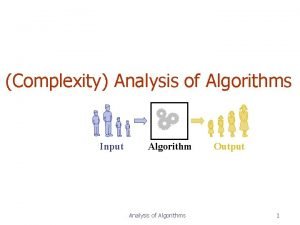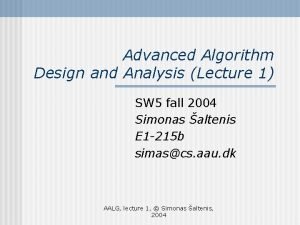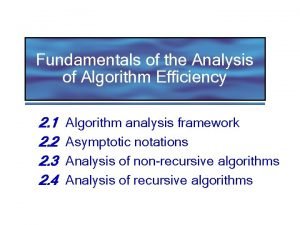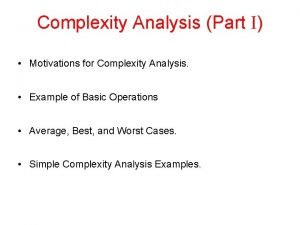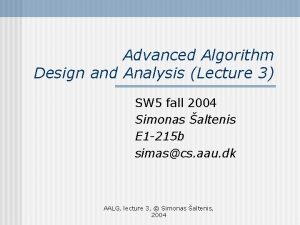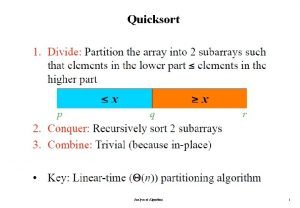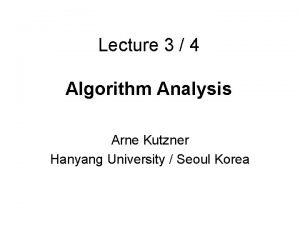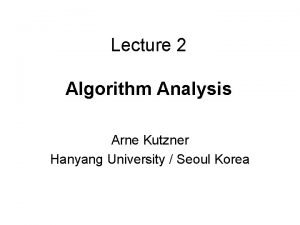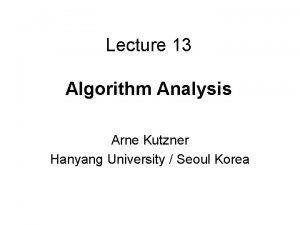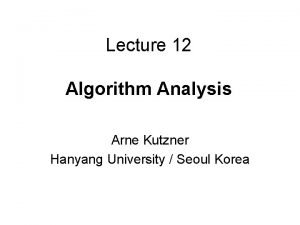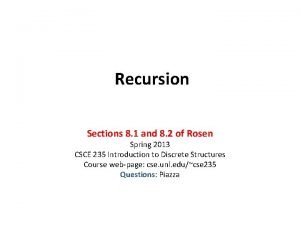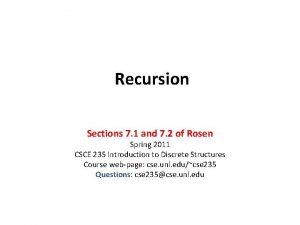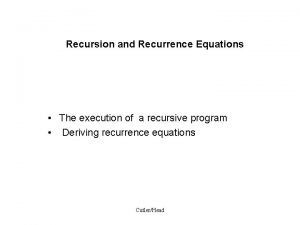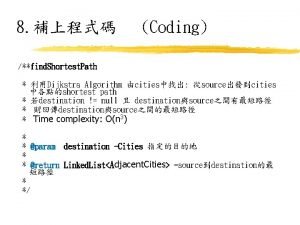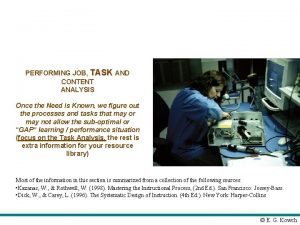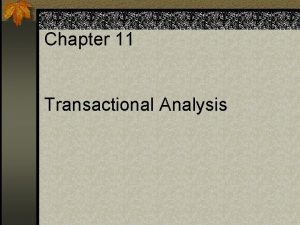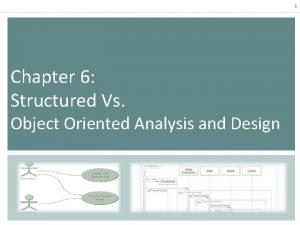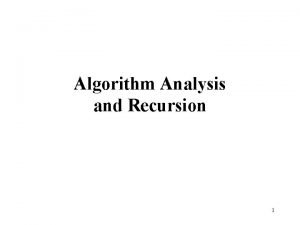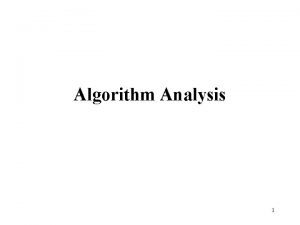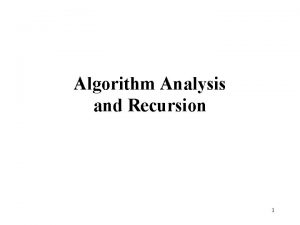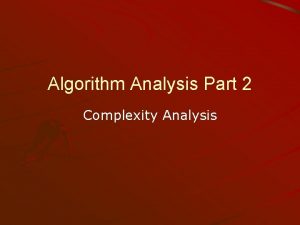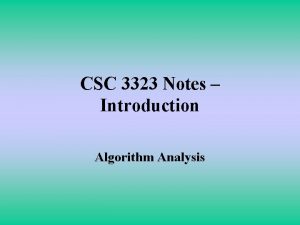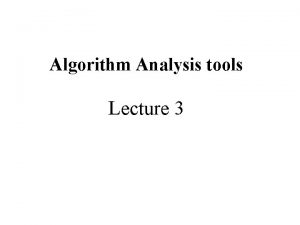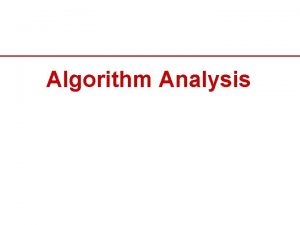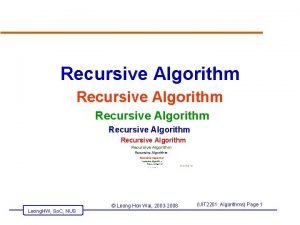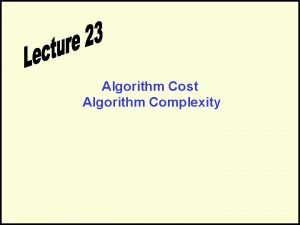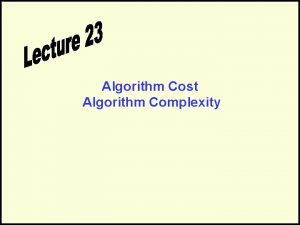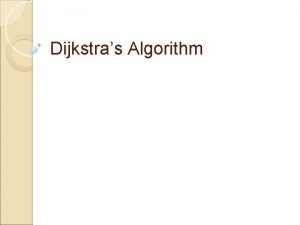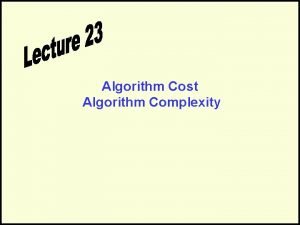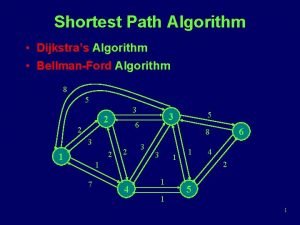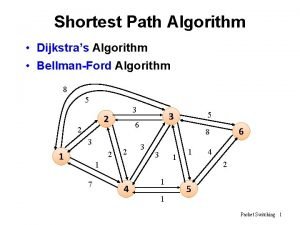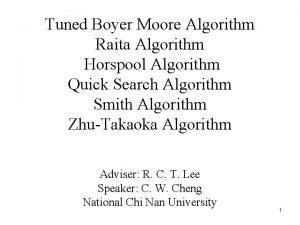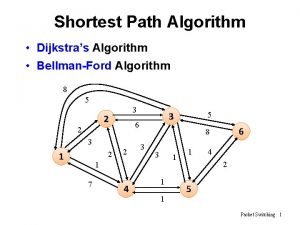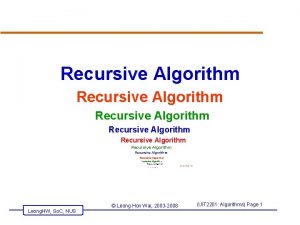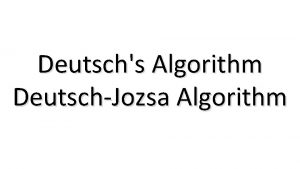Algorithm Analysis 1 Algorithm An algorithm is a
























![Sequential Search for i = 1 to N do if (target == list[i]) return Sequential Search for i = 1 to N do if (target == list[i]) return](https://slidetodoc.com/presentation_image_h2/997b3552de46b36124f645a65d66cb59/image-25.jpg)












- Slides: 37

Algorithm Analysis 1

Algorithm • An algorithm is a set of instructions to be followed to solve a problem. – There can be more than one solution (more than one algorithm) to solve a given problem. – An algorithm can be implemented using different programming languages on different platforms. • An algorithm must be correct. It should correctly solve the problem. • Once we have a correct algorithm for a problem, we have to determine the efficiency of that algorithm. 2

Algorithmic Performance There are two aspects of algorithmic performance: • Time • Instructions take time. • How fast does the algorithm perform? • What affects its runtime? • Space • Data structures take space • What kind of data structures can be used? • How does choice of data structure affect the runtime? Ø We will focus on time: – How to estimate the time required for an algorithm – How to reduce the time required 3

Analysis of Algorithms • When we analyze algorithms, we should employ mathematical techniques that analyze algorithms independently of specific implementations, computers, or data. • To analyze algorithms: – First, we start to count the number of significant operations in a particular solution to assess its efficiency. – Then, we will express the efficiency of algorithms using growth functions. 4

The Execution Time of Algorithms • Each operation in an algorithm (or a program) has a cost. Each operation takes a certain of time. count = count + 1; take a certain amount of time, but it is constant A sequence of operations: count = count + 1; sum = sum + count; Cost: c 1 Cost: c 2 Total Cost = c 1 + c 2 5

The Execution Time of Algorithms (cont. ) Example: Simple If-Statement if (n < 0) absval = -n else absval = n; Cost c 1 c 2 c 3 Times 1 1 1 Total Cost <= c 1 + max(c 2, c 3) 6

The Execution Time of Algorithms (cont. ) Example: Simple Loop i = 1; sum = 0; while (i <= n) { i = i + 1; n sum = sum + i; } Cost c 1 c 2 c 3 Times 1 1 n+1 c 4 c 5 n Total Cost = c 1 + c 2 + (n+1)*c 3 + n*c 4 + n*c 5 The time required for this algorithm is proportional to n 7

The Execution Time of Algorithms (cont. ) Example: Nested Loop Cost c 1 c 2 c 3 c 4 c 5 c 6 c 7 Times 1 1 n+1 n n*(n+1) n*n i=1; sum = 0; while (i <= n) { j=1; while (j <= n) { sum = sum + i; j = j + 1; } i = i +1; c 8 n } Total Cost = c 1 + c 2 + (n+1)*c 3 + n*c 4 + n*(n+1)*c 5+n*n*c 6+n*n*c 7+n*c 8 The time required for this algorithm is proportional to n 2 8

General Rules for Estimation • Loops: The running time of a loop is at most the running time of the statements inside of that loop times the number of iterations. • Nested Loops: Running time of a nested loop containing a statement in the inner most loop is the running time of statement multiplied by the product of the sized of all loops. • Consecutive Statements: Just add the running times of those consecutive statements. 9

Algorithm Growth Rates • We measure an algorithm’s time requirement as a function of the problem size. – Problem size depends on the application: e. g. number of elements in a list for a sorting algorithm. • So, for instance, we say that (if the problem size is n) – Algorithm A requires 5*n 2 time units to solve a problem of size n. – Algorithm B requires 7*n time units to solve a problem of size n. • The most important thing to learn is how quickly the algorithm’s time requirement grows as a function of the problem size. – Algorithm A requires time proportional to n 2. – Algorithm B requires time proportional to n. • An algorithm’s proportional time requirement is known as growth rate. • We can compare the efficiency of two algorithms by comparing their growth rates. CENG 213 Data Structures 10

Algorithm Growth Rates (cont. ) Time requirements as a function of the problem size n 11

Common Growth Rates Function c log N log 2 N N N log N N 2 N 3 2 N Growth Rate Name Constant Logarithmic Log-squared Linear Quadratic Cubic Exponential 12

Figure 6. 1 Running times for small inputs 13

Figure 6. 2 Running times for moderate inputs 14

Order-of-Magnitude Analysis and Big O Notation • If Algorithm A requires time proportional to f(n), Algorithm A is said to be order f(n), and it is denoted as O(f(n)). • The function f(n) is called the algorithm’s growth-rate function. • Since the capital O is used in the notation, this notation is called the Big O notation. • If Algorithm A requires time proportional to n 2, it is O(n 2). • If Algorithm A requires time proportional to n, it is O(n). 15

A Comparison of Growth-Rate Functions (cont. ) 16

Growth-Rate Functions O(1) O(log 2 n) Time requirement is constant, and it is independent of the problem’s size. Time requirement for a logarithmic algorithm increases slowly as the problem size increases. O(n) Time requirement for a linear algorithm increases directly with the size of the problem. O(n*log 2 n) Time requirement for a n*log 2 n algorithm increases more rapidly than a linear algorithm. O(n 2) Time requirement for a quadratic algorithm increases rapidly with the size of the problem. O(n 3) Time requirement for a cubic algorithm increases more rapidly with the size of the problem than the time requirement for a quadratic algorithm. O(2 n) As the size of the problem increases, the time requirement for an exponential algorithm increases too rapidly to be practical. CENG 213 Data Structures 17

Growth-Rate Functions • If an algorithm takes 1 second to run with the problem size 8, what is the time requirement (approximately) for that algorithm with the problem size 16? • If its order is: O(1) T(n) = 1 second O(log 2 n) T(n) = (1*log 216) / log 28 = 4/3 seconds O(n) T(n) = (1*16) / 8 = 2 seconds O(n*log 2 n) T(n) = (1*16*log 216) / 8*log 28 = 8/3 seconds O(n 2) T(n) = (1*162) / 82 = 4 seconds O(n 3) T(n) = (1*163) / 83 = 8 seconds O(2 n) T(n) = (1*216) / 28 = 28 seconds = 256 seconds 18

Properties of Growth-Rate Functions 1. We can ignore low-order terms in an algorithm’s growth-rate function. – If an algorithm is O(n 3+4 n 2+3 n), it is also O(n 3). – We only use the higher-order term as algorithm’s growth-rate function. 2. We can ignore a multiplicative constant in the higher-order term of an algorithm’s growth-rate function. – If an algorithm is O(5 n 3), it is also O(n 3). 3. O(f(n)) + O(g(n)) = O(f(n)+g(n)) – We can combine growth-rate functions. – If an algorithm is O(n 3) + O(4 n), it is also O(n 3 +4 n 2) So, it is O(n 3). – Similar rules hold for multiplication. 19

Some Mathematical Facts • Some mathematical equalities are: 20

Growth-Rate Functions – Example 1 i = 1; sum = 0; while (i <= n) { i = i + 1; n sum = sum + i; } Cost c 1 c 2 c 3 Times 1 1 n+1 c 4 c 5 n T(n) = c 1 + c 2 + (n+1)*c 3 + n*c 4 + n*c 5 = (c 3+c 4+c 5)*n + (c 1+c 2+c 3) = a*n + b So, the growth-rate function for this algorithm is O(n) 21

Growth-Rate Functions – Example 2 Cost c 1 c 2 c 3 c 4 c 5 c 6 c 7 Times 1 1 n+1 n n*(n+1) n*n i=1; sum = 0; while (i <= n) { j=1; while (j <= n) { sum = sum + i; j = j + 1; } i = i +1; c 8 n } T(n) = c 1 + c 2 + (n+1)*c 3 + n*c 4 + n*(n+1)*c 5+n*n*c 6+n*n*c 7+n*c 8 = (c 5+c 6+c 7)*n 2 + (c 3+c 4+c 5+c 8)*n + (c 1+c 2+c 3) = a*n 2 + b*n + c So, the growth-rate function for this algorithm is O(n 2) 22

What to Analyze • An algorithm can require different times to solve different problems of the same size. – Eg. Searching an item in a list of n elements using sequential search. Cost: 1, 2, . . . , n • Worst-Case Analysis –The maximum amount of time that an algorithm require to solve a problem of size n. – This gives an upper bound for the time complexity of an algorithm. – Normally, we try to find worst-case behavior of an algorithm. • Best-Case Analysis –The minimum amount of time that an algorithm require to solve a problem of size n. – The best case behavior of an algorithm is NOT so useful. • Average-Case Analysis –The average amount of time that an algorithm require to solve a problem of size n. – Sometimes, it is difficult to find the average-case behavior of an algorithm. – We have to look at all possible data organizations of a given size n, and their distribution probabilities of these organizations. – Worst-case analysis is more common than average-case analysis. 23

What is Important? • An array-based list retrieve operation is O(1), a linked-listbased list retrieve operation is O(n). • But insert and delete operations are much easier on a linked-listbased list implementation. When selecting the implementation of an Abstract Data Type (ADT), we have to consider how frequently particular ADT operations occur in a given application. • If the problem size is always small, we can probably ignore the algorithm’s efficiency. – In this case, we should choose the simplest algorithm. 24
![Sequential Search for i 1 to N do if target listi return Sequential Search for i = 1 to N do if (target == list[i]) return](https://slidetodoc.com/presentation_image_h2/997b3552de46b36124f645a65d66cb59/image-25.jpg)
Sequential Search for i = 1 to N do if (target == list[i]) return i end if end for return 0 // Not found Unsuccessful Search: O(n) Successful Search: Best-Case: item is in the first location of the array O(1) Worst-Case: item is in the last location of the array O(n) 25

Binary Search • • • • 1 2 3 4 5 6 7 8 9 10 11 12 13 14 int first = 0; int size ; int last = size – 1; int middle; boolean found = false; while ( first <= last && !found ) { middle = ( first + last ) /2 ; if ( item. To. Find == A[ middle ] ) found = true; else if ( item. To. Find < A[ middle ] ) last = middle – 1; else // item. To. Find > A[ middle ] first = middle + 1; } 26

Binary Search – Analysis • For an unsuccessful search: – The number of iterations in the loop is log 2 n + 1 O(log 2 n) • For a successful search: – Best-Case: The number of iterations is 1. – Worst-Case: The number of iterations is log 2 n +1 – Average-Case: The avg. # of iterations < log 2 n O(1) O(log 2 n) 27

How much better is O(log 2 n)? n 16 64 256 1024 (1 KB) 16, 384 131, 072 262, 144 524, 288 1, 048, 576 (1 MB) 1, 073, 741, 824 (1 GB) O(log 2 n) 4 6 8 10 14 17 18 19 20 30 28

Bubble Sorting Algorithm Analysis Algorithm: Input array of size N for(i=n-1; i>=1; i--) { for(y=1; y<=i; y++) { if(x[y-1]>x[y]) { temp=x[y-1]; x[y-1]=x[y]; x[y]=temp; } } } Output sorted array of Size N The worst case is the 1 st loop is executed n-1 times. The second loop is executed also n-1 times. (n-1)= n 2 -2 n+1 Which is O(n 2) 29

Bubble Sort – Analysis �Best-case: O(n) � Array is already sorted in ascending order. � The number of key comparisons: (n-1) �Worst-case: O(n) O(n 2) � Array is in reverse order: � Outer loop is executed n-1 times, � The number of key comparisons: (1+2+. . . +n-1)= n*(n-1)/2 O(n 2) �. �So, Bubble Sort is O(n 2) CENG 213 Data Structures 30

Selection Sort Algorithm Analysis 1. for fill = 0 to n-1 do 2. set pos. Min to fill for next = fill+1 to n-1 do 3. if item at next < item at pos. Min 4. set pos. Min to next 5. Exchange item at pos. Min with one at fill �In selection Sort function, the outer for loop executes n-1 times. �We invoke swap function once at each iteration. Total Swaps: n-1 Total Moves: 3*(n-1) (Each swap has three moves) 31

Selection Sort – Analysis (cont. ) �The inner for loop executes the size of the unsorted part minus 1 (from 1 to n-1), and in each iteration we make one key comparison. # of key comparisons = 1+2+. . . +n-1 = n*(n-1)/2 So, Selection sort is O(n 2) �The best case, the worst case, and the average case of the selection sort algorithm are same. all of them are O(n 2) � This means that the behavior of the selection sort algorithm does not depend on the initial organization of data. � Since O(n 2) grows so rapidly, the selection sort algorithm is appropriate only for small n. � Although the selection sort algorithm requires O(n 2) key comparisons, it only requires O(n) moves. 32

Insertion Sort analysis • for i = 2 to N do new. Element = list[ i ] location = i - 1 while (location ≥ 1) and (list[ location ] > new. Element) do list[ location + 1 ] = list[ location ] location = location - 1 end while list[ location + 1 ] = new. Element • end for 33

Insertion Sort – Analysis �Running time depends on not only the size of the array but also the contents of the array. �Best-case: O(n) � Array is already sorted in ascending order. � Inner loop will not be executed. � The number of moves: 2*(n-1) O(n) � The number of key comparisons: (n-1) O(n) �Worst-case: O(n 2) � Array is in reverse order: � Inner loop is executed i-1 times, for i = 2, 3, …, n � The number of moves: 2*(n-1)+(1+2+. . . +n-1)= 2*(n-1)+ n*(n-1)/2 � The number of key comparisons: (1+2+. . . +n-1)= n*(n-1)/2 �Average-case: O(n 2) � We have to look at all possible initial data organizations. �So, Insertion Sort is O(n 2) 34

Summary • Bubble sort, selection sort, and insertion sort are all O(n 2) • Within O(n 2), – Bubble sort is very slow, and should probably never be used for anything – Selection sort is intermediate in speed – Insertion sort is usually the fastest of the three--in fact, for small arrays (say, 10 or 15 elements), insertion sort is faster than more complicated sorting algorithms • Selection sort and insertion sort are “good enough” for small arrays 35

Quicksort – Analysis Worst Case: (assume that we are selecting the first element as pivot) � The pivot divides the list of size n into two sublists of sizes 0 and n-1. � The number of key comparisons = n-1 + n-2 +. . . + 1 = n 2/2 – n/2 O(n 2) � The number of swaps = = n-1 + n-2 +. . . + 1 swaps outside of the for loop = n 2/2 + n/2 - 1 swaps inside of the for loop O(n 2) � So, Quicksort is O(n 2) in worst case 36

Heap Sort • Build Heap Algorithm will run in O(n) time • There are n-1 calls to Heapify each call requires O(log n) time • Heap sort program combine Build Heap program and Heapify, therefore it has the running time of O(n log n) time : Ø The call to Build. Heap() takes O(n) time. Ø Each of the n - 1 calls to Heapify() takes O( lg n) time. Ø Thus the total time taken by Heapsort() = O(n) + (n - 1) O(lg n) = O(n) + O(n lg n) • Total time complexity: O(n log n) 37
 Ao* search algorithm
Ao* search algorithm Adri wessels
Adri wessels Algorithm analysis examples
Algorithm analysis examples Anany levitin
Anany levitin Brute force in design and analysis of algorithm
Brute force in design and analysis of algorithm Pseudocode with functions
Pseudocode with functions Algorithm analysis examples
Algorithm analysis examples Time complexity for algorithms
Time complexity for algorithms Algorithm analysis examples
Algorithm analysis examples Analysis of algorithms
Analysis of algorithms Algorithm analysis examples
Algorithm analysis examples Mathematical analysis of recursive algorithm
Mathematical analysis of recursive algorithm Measuring algorithm efficiency
Measuring algorithm efficiency Algorithm complexity analysis
Algorithm complexity analysis Advanced algorithm design
Advanced algorithm design Measuring algorithm efficiency
Measuring algorithm efficiency Quick sort worst complexity
Quick sort worst complexity Advanced algorithm analysis
Advanced algorithm analysis Algorithm analysis
Algorithm analysis Algorithm analysis
Algorithm analysis Algorithm analysis
Algorithm analysis Algorithm analysis
Algorithm analysis Prim's algorithm pseudocode
Prim's algorithm pseudocode Example of non recursive algorithm
Example of non recursive algorithm How to cheat in
How to cheat in Mathematical analysis of recursive algorithm
Mathematical analysis of recursive algorithm Mathematical analysis of recursive algorithm
Mathematical analysis of recursive algorithm Analysis of algorithms
Analysis of algorithms Dijkstra algorithm complexity analysis
Dijkstra algorithm complexity analysis Structured analysis
Structured analysis Autohotkey obfuscator
Autohotkey obfuscator Content analysis versus discourse analysis
Content analysis versus discourse analysis Differences between error analysis and contrastive analysis
Differences between error analysis and contrastive analysis Contrastive analysis error analysis and interlanguage
Contrastive analysis error analysis and interlanguage Types of fact gathering in system analysis and design
Types of fact gathering in system analysis and design Job content analysis
Job content analysis Transactions in transactional analysis
Transactions in transactional analysis Structured vs object oriented approach
Structured vs object oriented approach





